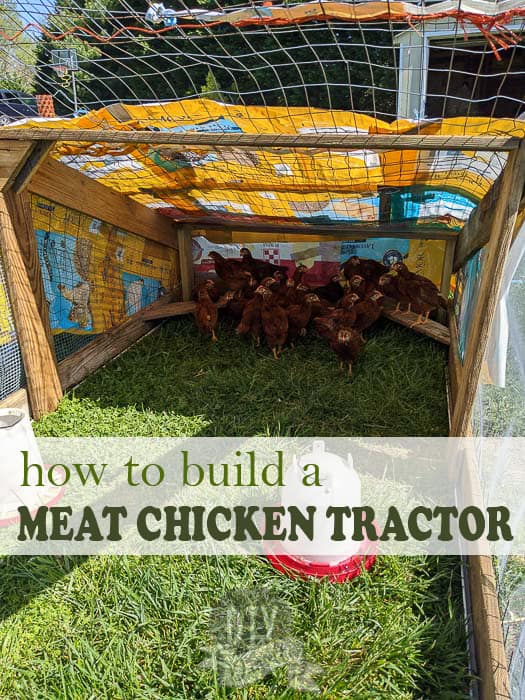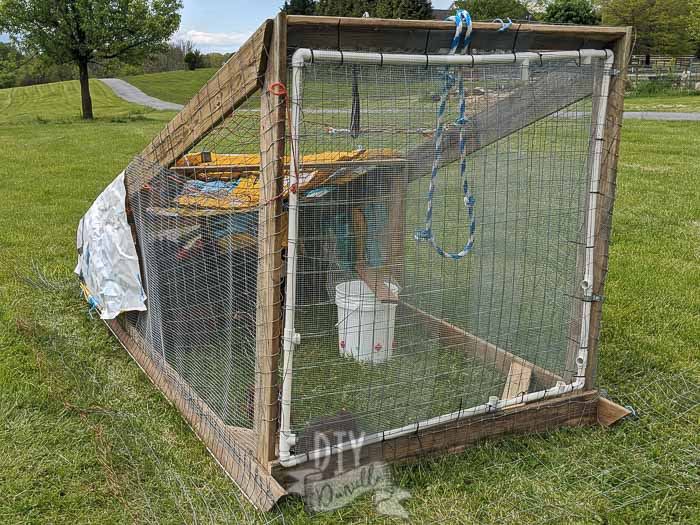
Everything you need to know about chicken tractors, and how to build a chicken tractor for your meat chickens! Includes woodworking plans!
This post may contain affiliate links which may earn me commissions should you click through them and take certain actions. As an affiliate for Amazon, Cricut, xTool, Home Depot, and other sites, I earn from qualifying purchases. Please DIY carefully. View my full legal disclosures here.
Please read the whole post so you don’t miss any important information!
We raised meat chickens last year in a coop and run. It was stinky and I found that the cost of bedding adds up quickly. Here’s a detailed guide with cost breakdown to raising Cornish X meat chickens.
By cutting out the cost of pine shavings, I could potentially save a lot of money and set up my chickens with fresh natural “bedding” (aka grass).
It also allowed me to keep the chickens and Muscovy duck in separate areas. My ducks are in the coop and run, and I didn’t want to move critters around.
Now… my tractor isn’t the immaculate shrine of awesomeness that I like my woodworking projects to be. Simply put, had I made it like I wanted, it would be too heavy to move. So I made some adjustments to make it lighter where I could. The adjustments were cosmetic items.
Table of contents
What is a Chicken Tractor?
In case you aren’t familiar with the term, a chicken tractor is simply a movable chicken coop. They’re a bit simpler to build. The “tractor” is
Chicken Tractor Vs. Coop
Here’s my thoughts on a chicken tractor vs. a coop.
Chicken Tractor
- Affordable
- Portable
- Lightweight
- Fresh bedding daily (grass, free)
- Less cleaning
- Space for the birds to move without them getting too muscular
- Birds fertilize your grass
- No cleaning out chicken bedding (which can be a health hazard)
- Lots of ventilation
Coop
- Expensive
- Attractive
- More secure
- Larger
- Easier to collect eggs
- Can run electricity and water to it.
- Handles snow loads, wind, and large predators (ie. bears)
- Warmer for areas where it’s really cold.
Personally, I believe in creating a predator-proof chicken run attached to any coop that you build. So you need to consider the expense of the run + the coop if that’s what you want to do.
For a permanent flock of egg/pet chickens, I think a coop makes a lot of sense.
Meat birds, however, are a different situation. You’re only raising them for 12-14 weeks. I want them to have a good life: clean housing, fresh water, sunshine, lots of bugs to eat, treats, and movement; they won’t get that at a factory farm.
On the other hand, I don’t want them exercising either; you are trying to raise them on as little feed as possible and you want your birds to gain fat, not muscle. I made this mistake when raising free range Muscovy to eat. The meat was TOUGH and muscular.
So you’re trying to find a balance between lazing around in their own excrement (not cool) and going for a daily 1 mile walkabout. The chicken tractor provides that.
Obviously my “pros” to each are sort of dependent on who is building it. A coop is generally more attractive, but you could certainly build a top notch fancy tractor too!
Considerations for a Chicken Tractor
Chickens are a pretty major investment so you don’t want to feed the local fox population if you can avoid it. There are some safety considerations that you need to take into account when you build the movable coop.
Size
The tractor needs to be small enough that you can move it easily, but big enough for your flock of chickens. You’re aiming for 2′ sq ft of space per meat chicken.
This tractor is a bit small for my flock, but not by much. I plan to move it daily instead of weekly so that should help keep it from being too dirty.
I am planning to make a second tractor so I can split them between the two. It will also give me an opportunity to test out which works better.
Safety
I’ve seen people keep chickens in these with only chicken wire for the sides. This will not keep out a persistent predator. You can run electric wire around the area in hopes that would help or keep a livestock guardian dog to guard it. But I didn’t like either of those options for my small homestead.
While I like to save money, I’d rather not lose a flock of chickens to our fox. If I purchase meat chicks for $2-3/bird, I’m losing that cost + the feed costs whenever a fox gets one. We lost three adult ducks last year to a fox.
Some people sit around with a gun to shoot the fox, but I find other predators will just take his place and that takes time. Plus I’m hoping the fox will snack on the local rabbit population so I don’t have to contend with them in my garden.
I simply need to make it HARDER to eat my poultry than it is for him to catch a rabbit.
To prevent a predator from getting in, I added an “apron” of welded wire on the ground along the sides, back, and front of the tractor so he couldn’t dig under easily.
I also used hardware cloth for the door and the lower half of the tractor sides. This keeps predators from reaching their paws in. Here’s a guide to wire fencing that I wrote recently.
Portability
The MAIN point of a chicken tractor is that it’s portable. You need it to be light enough to move, preferably by hand. The more you can move it, the more frequently your chickens are sitting in fresh grass and not in their own excrement.
You can make it portable with two different methods- using wheels or using skids. For this tractor, I used PVC pipe cut in half as skids. This has worked really well and allows the tractor to move without gouging the ground as it moves; the weight is distributed evenly as I pull.
The other nice part is that I don’t need to pick up one end of the tractor very high. I can pull as it sits on the ground. I’m pulling forward instead of forward AND up.
You don’t need to pull this tractor far. I pull mine the length of the run each day… this gives them fresh grass for the whole tractor “floor.” It’s heavy, but not impossible to move.
Durability
Dragging a chicken tractor around is going to impact its longevity; you want a sturdy tractor. You don’t want to cut corners on some parts of your build.
My husband suggested I use thinner wood for this to make it lighter weight. My problem is that our goats escape at LEAST a couple times a month. And well, they’re goats. They immediately climb on whatever looks fun. I KNEW they’d go for the chicken tractor so I built it so they hopefully wouldn’t immediately destroy it.
By the way, they DID go for it, and YES it supported their weight.
Let’s talk about how I built this structure.
Supplies for a DIY Chicken Tractor
- Wood: You want something pressure treated or that can withstand the outdoors. I would probably go with pressure treated 2x4s if I were buying supplies.
- Welded wire
- Hardware cloth
- Poultry staples
- PVC for skids: We think we used 3-4″ PVC pipe but bigger might be better here.
- PVC for the door: We used 1-1.5″ PVC for the door, but bigger might be better here as well.
- Hinges for the door: We used these brackets that were the correct size for our PVC
- Lots of heavy duty zip ties
- Strong Rope
- Feed bags for a DIY tarp, duct tape, & hay bale string for holding it on.
- SOMETHING to hold the door closed. I’ve been using baling twine and a dog leash, but something easier to hook and unhook is better. I need to scavenge our garage to see what I can use.
Need an easy shelter and don’t want to DIY? Here’s what you can buy.
Omlet makes a ton of chicken shelters and runs that are movable and have lots of accessories available. You can add wheels and handles to move the run as needed which is nice. The cages look like they’re well predator-proofed, and you can get an attached run up to 13′. They even sell an automatic coop door that opens and closes when the sun rises and sets. The Eglu Go is their easily movable shelter and run. They have perches to add on, swings, treat holders, and even chicken clothing. Totally worth checking out if you like to geek out over your poultry.
Meat Chicken Tractor Plans
I’m going to give you the basic layout and plans for my chicken tractor; once I experiment with a second tractor, I’ll try to put together a more formal set of plans. I think a shorter height in the front will reduce the weight on this quite a bit.
Sign up for the waiting list for the official woodworking plan below!
My tractor was made with scrap wood, PVC and wire that I had laying around. This tractor was essentially FREE to make.
My first plan was to use wire under it. You’ll see wire underneath it in a few pictures- ignore it.
I started with the base. For my length, I used the longest boards I could find in our scrap pile and cut them to the same length. The same went for the shorter ends.
Leftover scraps were used to stabilize the base. Each side of 4 pieces of scrap wood was cut at a 90 degree angle; I screwed in all four corner pieces.
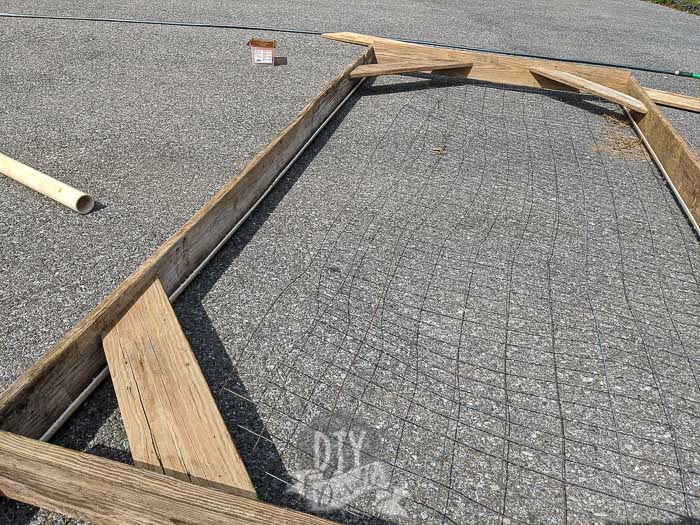
Once the base was built, we cut some larger PVC pipes in half and use one half per long size. These help slide the tractor over the grass. They’re a MUCH less expensive option than adding wheels.
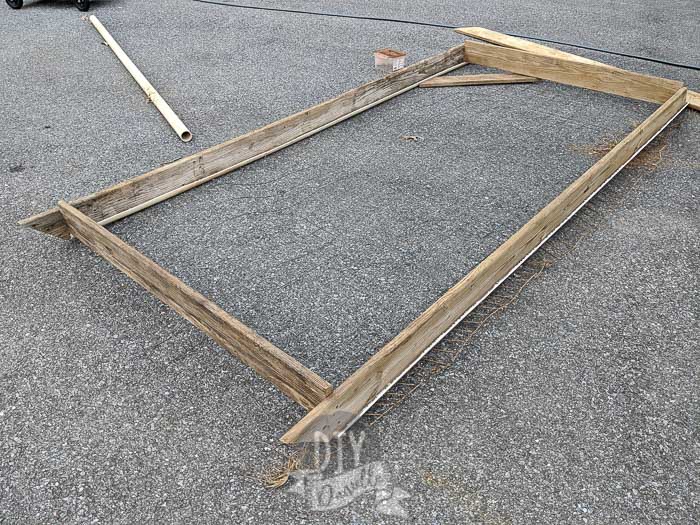
At this point I needed to build up. I liked the idea of the A frame so snow would fall off in the winter, but decided on this shape instead. Same functionality, but it felt like the birds would have more vertical space.
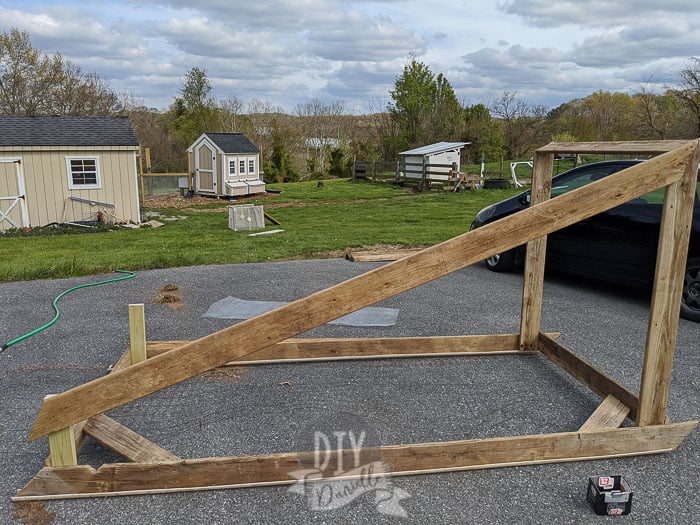
The short end was intended to be the covered zone for the birds to escape from wind and rain.

I added some additional boards in the middle for further support. I was worried the wire by itself wouldn’t be supportive enough against a predator if I didn’t have this.
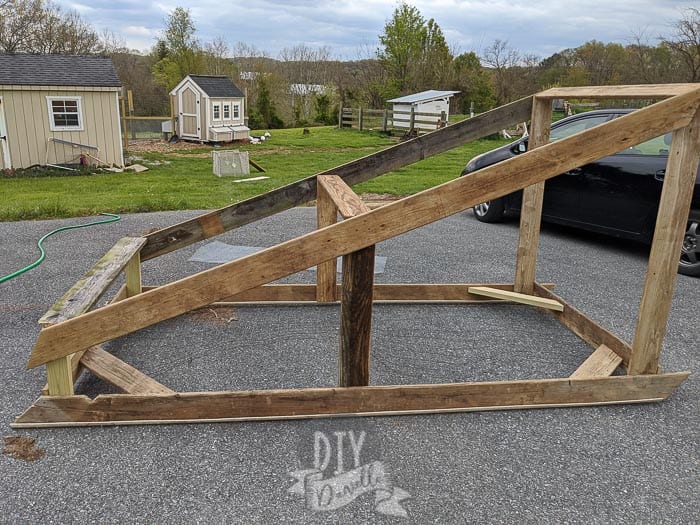
Once this frame was built, all that was left was adding the wire. I wanted hardware cloth for the door and along the bottom half of this tractor. The top could be welded wire.
I attached the wire with poultry staples and a hammer (brutal work). In areas where the wire overlaps, I used hay twine, zip ties, or wove pieces of feed bags through to help stabilize the wire and connect them.
Mostly though, I tried to make sure there were poultry staples wherever wire overlapped, hammered directly into the wood.

Here is my setup as I duct taped feed bags together to create a “tarp” for the end of the tractor. This should help provide cover from the rain and wind for my birds. Tarps or feed bags are light weight so they don’t add true weight to your structure.
I made small holes in the “tarp” and use twine to attach the tarp to the wire. We get pretty strong wind so I didn’t want this to blow off.
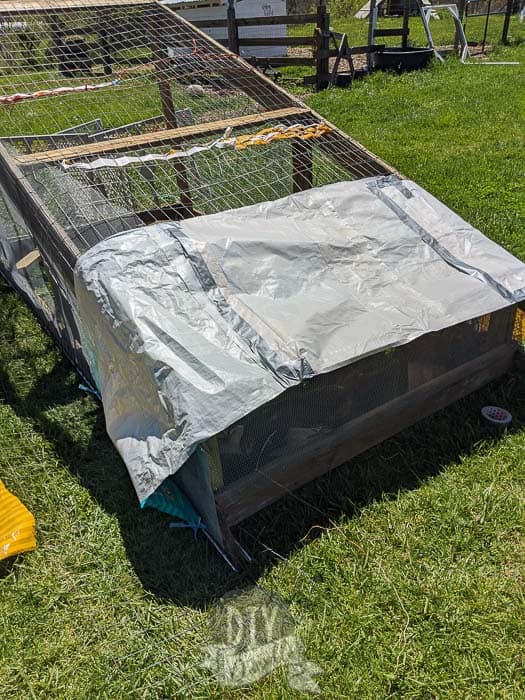
By the time I got to the door, I knew I didn’t want the structure to get any heavier. I used PVC for the door. It’s double wrapped in welded wire, then (not shown) I stuck hardware cloth in between the welded wire. I zip tied it all to the door.
It’s not attractive, but it should hopefully be SAFE.

I’m not sure if you can see it well in any of the finished photos, but I attached welded wire like an apron around the entire tractor. This should help keep fox from digging under the tractor.
And it’s done… keep scrolling for the finished photos. I’m hoping this will hold up well and the fox won’t be able to find a way in. It’s SUPER easy to trip over so we have to be careful when we walk over to the chickens.
I have a rope I can take on and off; this is what I use to pull the structure. So far the chickens seem to be catching on to move when I pull it.
Share this post!
Please share and pin this post! If you make this project, share it in our Stuff Mama Makes Facebook Group. We have regular giveaways for gift cards to craft stores. You can also tag me on Instagram @doityourselfdanielle; I love seeing everything you make!


